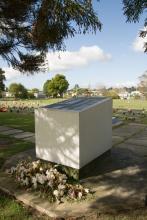From a story submitted by Jane Hindle for William Nicholls, who was also killed on this aircraft:
"The Lockheed Hudson Mk III maritime reconnaissance-bomber No NZ2064 of Number 1 Squadron, RNZAF departed on 5th May 1943. The Hudson and its crew arrived safely at Waipapakauri that afternoon where it was refuelled and subjected to normal "between flights" inspection being found in all aspects airworthy. This aircraft was to proceed on operational patrol from Waipapakauri before dawn on 6th May. Early next morning Pilot Officer C Ansley, Aerodrome Control Officer at Waipapakauri, laid the flare-path into the wind, taking full advantage of the stipulated length of the runway. He then stationed himself at the control position by the chance-light ready to despatch the Hudson on its early patrol. The normal take-off procedure at Waipapakauri that morning, in the conditions then prevailing (a south-westerly wind, blowing at 5-10 miles per hour was for the pilot to taxi his aircraft up to the Number 1 flare, swing round INTO the wind and take-off towards the south-west. No taxiing post was put out, however, as it restricted the space for the aircraft to manoeuvre into the narrow runway. Flying Officer B Scott, the bomber's pilot was an experienced flyer, having accumulated over 700 hours on the Hudson type alone. However, he had never flown from Waipapakauri before and he did NOT report that morning to the Operations Officer, who would have told him the wind-direction and local take-off procedure prior to taking off. After breakfast at 0500 hours, Flying Officer Scott and his crew, with the exception of the navigator, Flight Sergeant Triner reported to the Operations Room to procure a weather report, latest shipping information and secret documents. Once the navigator was back on board, the engines were run up and the aircraft taxied out. Flight officer Scott had already decided to take-off from the end of the flare path nearest to him - the south-western end. To the pilot it appeared there was no wind (there was NO illuminated wind-indicator displayed) and there was nothing in the lay-out of the flare path to indicate that he would be wrong in taking-off from that point. He was also aware that the runway was shorter than those he was normally used to and that in taking-off in this direction, there were no obstructions. Without having received permission to take-off from the Aerodrome Control Officer, Flight Officer Scott turned onto the flare-path, opened the throttles and took off. The aircraft was now rapidly gaining speed and proceeding down the eastern side of the runway (normally reserved for emergency-landings only) directly towards Pilot Officer Ansley and the chance-light. Those on the ground watching could see a tragedy unfolding before their eyes. A car was driven onto the flare-path in an attempt to stop the pilot, while Pilot officer Ansley frantically direct the red Aldis Lamp onto the approaching aircraft to indicate it was taking off in the wrong direction. Their efforts were to no avail - as Flight Officer Scott, aware of the short runway, had opened the throttles more quickly than usual and was already airborne. It was only at this point, approaching the end of the flare-path, that he became aware of the chance-light and realised that he would have to pull the aircraft up smartly to avoid crashing into it. Putting the Hudson into a steep climbing altitude, he managed to clear the beacon, but at an indicated air-speed of only 80 knots, the aircraft could not climb further and stalled. After attaining a height of approximately 30 feet, the Hudson sank back into the ground, still apparently flying straight and level, before crashing into the swamp-land beyond the runway and bursting into flames. The fire tender and ambulance immediately proceeded to the crash site, where they found Flight Officer Scott and Flight Sergeant R Black standing, severely shocked, in the vicinity of the wreckage. Of flight Sergeant Triner or Sergeant William Nicholls there was no sign. Approximately 20 minutes after the initial crash, a further, greater explosion took place as the depth charges carried aboard the aircraft blew up - completely demolishing it"



